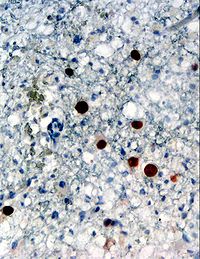JC virus
| JC virus | |
|---|---|
 |
|
| detection of JC virus protein (stained brown) in a brain biopsy (glial cells demonstrating progressive multifocal leukoencephalopathy (PML)) | |
| Virus classification | |
| Group: | Group I (dsDNA) |
| Family: | Polyomaviridae |
| Genus: | Polyomavirus |
| Species: | JC polyomavirus |
The JC virus or John Cunningham virus (JCV, not to be confused with Jamestown Canyon virus that bears the same initials) is a type of human polyomavirus (formerly known as papovavirus) and is genetically similar to BK virus and SV40. It was identified by electron microscopy in 1965 by ZuRhein and Chou, and by Silverman and Rubinstein, and later isolated in culture and named using the two initials of a patient, John Cunningham, with progressive multifocal leukoencephalopathy (PML). The virus causes PML and other diseases only in cases of immunodeficiency, as in AIDS or during treatment with drugs intended to induce a state of immunosuppression (e.g. organ transplant patients).
The virus is very common in the general population, infecting 70% to 90% of humans; most people acquire JCV in childhood or adolescence. It is found in high concentrations in urban sewage worldwide, leading some researchers to suspect contaminated water as a typical route of infection.
Minor genetic variations are found consistently in different geographic areas; thus, genetic analysis of JC virus samples has been useful in tracing the history of human migration. 14 subtypes or genotypes are recognised each associated with a specific geographical region. Three are found in Europe (a, b and c). A minor African type—Af1—occurs in Central and West Africa. The major African type—Af2—is found throughout Africa and also in West and South Asia. Several Asian types are recognised B1-a, B1-b, B1-d, B2, CY, MY and SC.
An alternative numbering scheme numbers the genotypes 1–8 with additional lettering. Types 1 and 4 are found in Europe and in indigenous populations in northern Japan, North-East Siberia and northern Canada. These two types are closely related. Types 3 and 6 are found in sub-Saharan Africa: type 3 was isolated in Ethiopia, Tanzania and South Africa. Type 6 is found in Ghana. Both types are also found in the Biaka Pygmies and Bantus from Central Africa. Type 2 has several variants: subtype 2A is found mainly in the Japanese population and Native Americans (excluding Inuit); 2B is found in Eurasians; 2D is found in Indians and 2E is found in Australians and western Pacific populations. Subtype 7A is found in southern China and South-East Asia. Subtype 7B is found in northern China, Mongolia and Japan Subtype 7C is found in northern and southern China. Subtype 8 is found in Papua New Guinea and the Pacific Islands.
...
Wikipedia
